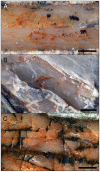Was dinosaurian physiology inherited by birds? Reconciling slow growth in archaeopteryx
- PMID: 19816582
- PMCID: PMC2756958
- DOI: 10.1371/journal.pone.0007390
Was dinosaurian physiology inherited by birds? Reconciling slow growth in archaeopteryx
Abstract
Background: Archaeopteryx is the oldest and most primitive known bird (Avialae). It is believed that the growth and energetic physiology of basalmost birds such as Archaeopteryx were inherited in their entirety from non-avialan dinosaurs. This hypothesis predicts that the long bones in these birds formed using rapidly growing, well-vascularized woven tissue typical of non-avialan dinosaurs.
Methodology/principal findings: We report that Archaeopteryx long bones are composed of nearly avascular parallel-fibered bone. This is among the slowest growing osseous tissues and is common in ectothermic reptiles. These findings dispute the hypothesis that non-avialan dinosaur growth and physiology were inherited in totality by the first birds. Examining these findings in a phylogenetic context required intensive sampling of outgroup dinosaurs and basalmost birds. Our results demonstrate the presence of a scale-dependent maniraptoran histological continuum that Archaeopteryx and other basalmost birds follow. Growth analysis for Archaeopteryx suggests that these animals showed exponential growth rates like non-avialan dinosaurs, three times slower than living precocial birds, but still within the lowermost range for all endothermic vertebrates.
Conclusions/significance: The unexpected histology of Archaeopteryx and other basalmost birds is actually consistent with retention of the phylogenetically earlier paravian dinosaur condition when size is considered. The first birds were simply feathered dinosaurs with respect to growth and energetic physiology. The evolution of the novel pattern in modern forms occurred later in the group's history.
Conflict of interest statement
Figures









Similar articles
-
Evolutionary origins of the avian brain.Nature. 2013 Sep 5;501(7465):93-6. doi: 10.1038/nature12424. Epub 2013 Jul 31. Nature. 2013. PMID: 23903660
-
Do feathered dinosaurs exist? Testing the hypothesis on neontological and paleontological evidence.J Morphol. 2005 Nov;266(2):125-66. doi: 10.1002/jmor.10382. J Morphol. 2005. PMID: 16217748
-
A Jurassic avialan dinosaur from China resolves the early phylogenetic history of birds.Nature. 2013 Jun 20;498(7454):359-62. doi: 10.1038/nature12168. Epub 2013 May 29. Nature. 2013. PMID: 23719374
-
Morphology and distribution of scales, dermal ossifications, and other non-feather integumentary structures in non-avialan theropod dinosaurs.Biol Rev Camb Philos Soc. 2022 Jun;97(3):960-1004. doi: 10.1111/brv.12829. Epub 2022 Jan 6. Biol Rev Camb Philos Soc. 2022. PMID: 34991180 Review.
-
From extant to extinct: locomotor ontogeny and the evolution of avian flight.Trends Ecol Evol. 2012 May;27(5):296-305. doi: 10.1016/j.tree.2011.12.003. Epub 2012 Feb 1. Trends Ecol Evol. 2012. PMID: 22304966 Review.
Cited by
-
Brain shapes of large-bodied, flightless ratites (Aves: Palaeognathae) emerge through distinct developmental allometries.R Soc Open Sci. 2024 Sep 11;11(9):240765. doi: 10.1098/rsos.240765. eCollection 2024 Sep. R Soc Open Sci. 2024. PMID: 39263457 Free PMC article.
-
Endocranial development in non-avian dinosaurs reveals an ontogenetic brain trajectory distinct from extant archosaurs.Nat Commun. 2024 Aug 28;15(1):7415. doi: 10.1038/s41467-024-51627-9. Nat Commun. 2024. PMID: 39198439 Free PMC article.
-
Earliest evidence of avian primary feather moult.Biol Lett. 2024 Jun;20(7):20240106. doi: 10.1098/rsbl.2024.0106. Epub 2024 Jul 3. Biol Lett. 2024. PMID: 38955226
-
High-energy synchrotron-radiation-based X-ray micro-tomography enables non-destructive and micro-scale palaeohistological assessment of macro-scale fossil dinosaur bones.J Synchrotron Radiat. 2023 May 1;30(Pt 3):627-633. doi: 10.1107/S1600577523001790. Epub 2023 Apr 7. J Synchrotron Radiat. 2023. PMID: 37026390 Free PMC article.
-
Decoupling body shape and mass distribution in birds and their dinosaurian ancestors.Nat Commun. 2023 Mar 22;14(1):1575. doi: 10.1038/s41467-023-37317-y. Nat Commun. 2023. PMID: 36949094 Free PMC article.
References
-
- Gill FB. New York: WH Freeman; 2007. Ornithology, 3rd ed.758
-
- Chiappe LM. Sydney: University of New South Wales Press; 2007. Glorified Dinosaurs: The Origin and Early Evolution of Birds.263
-
- Chiappe LM, Witmer LM, editors. Berkeley: University of California Press; 2002. Mesozoic Birds: Above the Heads of Dinosaurs.520
-
- Gauthier J, Gall LF, editors. New Haven: Peabody Museum of Natural History; 2001. New Perspectives on the Origin and Early Evolution of Birds.613
-
- Chinsamy A. Baltimore: Johns Hopkins Press; 2005. The Microstructure of Dinosaur Bone: Deciphering Biology with Fine-Scale Techniques.195
Publication types
MeSH terms
LinkOut - more resources
Full Text Sources


